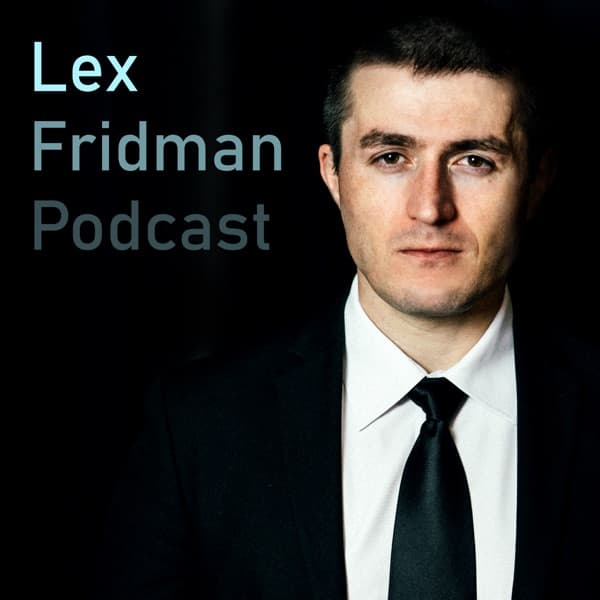How I Built This with Guy Raz: The episode discusses Todd Graves' journey in building Raising Cane's, a successful fast-food chain, focusing on simplicity and quality over variety.
Lex Fridman Podcast: A conversation with Ukrainian President Volodyrmyr Zelensky discussing language, history, and the ongoing war with Russia.
The Twenty Minute VC (20VC): Venture Capital | Startup Funding | The Pitch: The discussion focuses on seed investing strategies, emphasizing the importance of risk management, finding inefficiencies, and the power of the Pareto principle in venture capital.
Modern Wisdom: The discussion revolves around political labeling, societal issues, and the impact of political leadership on societal values and economic growth.
How I Built This with Guy Raz - Raising Cane's: Todd Graves (REPEAT)

Todd Graves, founder of Raising Cane's, built a successful fast-food chain by focusing on a simple menu of chicken fingers, fries, Texas toast, and coleslaw. Despite initial skepticism and financial challenges, Graves persisted with his vision, emphasizing quality and consistency. He raised initial funds through unconventional means, including working dangerous jobs like boilermaking and Alaskan fishing. Graves resisted industry trends to diversify menus, maintaining a focus on his core offerings. This strategy led Raising Cane's to become one of the most profitable fast-food chains per location, second only to Chick-fil-A. Graves' story highlights the importance of sticking to a clear vision and adapting creatively to financial constraints.
Key Points:
- Focus on a simple, high-quality menu to differentiate from competitors.
- Raise initial capital through unconventional means if necessary.
- Resist pressure to diversify offerings; stick to core strengths.
- Leverage personal networks and community support for growth.
- Maintain control over operations to ensure quality and consistency.
Details:
1. 🎧 Wondery Plus and Airbnb Opportunities
1.1. Wondery Plus Benefits
1.2. Subscription Options
1.3. Airbnb Hosting Potential
1.4. Airbnb Experience Example
2. 📝 Enhance Writing with Grammarly's AI
2.1. Introduction to Grammarly's AI
2.2. Grammarly's Role in Writing
2.3. Enterprise-Grade Security
2.4. Integration with Business Tools
2.5. Call to Action
3. 📊 Navigate Financial Choices with NerdWallet
- NerdWallet has reviewed over 1,100 financial products, including credit cards and savings accounts, to compile the 2025 Best of Awards.
- The awards aim to simplify consumer financial decision-making by identifying top-performing financial products.
- The 2025 Best of Awards can be accessed at nerdwallet.com/awards, providing an easy resource for consumers to find vetted financial products.
4. 🍗 Building Raising Cane's: A Journey of Persistence
4.1. Introduction and Expansion
4.2. Todd Graves' Journey
4.3. Raising Cane's Success and Menu
4.4. Challenges and Initial Vision
4.5. Focused Business Model
4.6. Ignoring Conventional Wisdom
4.7. Financing Challenges
4.8. Boilermaker and Alaskan Fishing Experience
4.9. Investor Support and SBA Loan
4.10. Construction and Learning
4.11. Naming and Branding
4.12. Opening Day
5. 🚀 Challenges and Growth of Raising Cane's
5.1. Expansion and Initial Challenges
5.2. Rapid Expansion and Franchise Considerations
5.3. Franchising Challenges and Shift to Company-Owned Stores
5.4. Financial Strategy and Resilience
5.5. Core Values and Success Metrics
5.6. Current Growth and Future Outlook
6. 🎙️ Conclusion and Listener Engagement
6.1. Show Promotion and Subscription Options
6.2. Rakuten Cashback Opportunities
Lex Fridman Podcast - #456 – Volodymyr Zelenskyy: Ukraine, War, Peace, Putin, Trump, NATO, and Freedom

The conversation with President Zelensky was conducted in multiple languages, highlighting the complexity of language in times of war. Zelensky, fluent in Russian, Ukrainian, and some English, discussed the symbolic importance of the Ukrainian language in the fight for independence. The conversation touched on historical events, including Ukraine's independence in 1991, the Orange Revolution, and the ongoing conflict with Russia, emphasizing the challenges of peace negotiations. Zelensky expressed the need for strong security guarantees and the importance of international support, particularly from the United States and NATO, to ensure Ukraine's sovereignty and peace. The discussion also covered the impact of war on democracy and the necessity of balancing freedom with security during conflict. Zelensky highlighted the importance of digitalization and economic reforms for Ukraine's future, emphasizing the need for international investment and partnerships.
Key Points:
- Language choice in the conversation was symbolic, reflecting Ukraine's fight for independence.
- Historical context included Ukraine's independence, the Orange Revolution, and ongoing conflict with Russia.
- Zelensky emphasized the need for strong security guarantees and international support for peace.
- The impact of war on democracy was discussed, highlighting the balance between freedom and security.
- Future of Ukraine includes digitalization, economic reforms, and international partnerships.
Details:
1. Introduction and Language Choice 🌍
1.1. Introduction
1.2. Language Choice and Historical Context
2. Conversation Dynamics and Language Barriers 🗣️
2.1. Language Challenges
2.2. Strategic Language Choice
3. Historical Context and Zelensky's Background 📜
- Captions and voice-over audio tracks are available in English, Ukrainian, and Russian, enhancing accessibility.
- Users can change language audio tracks on YouTube by clicking the settings gear icon, showcasing the platform's flexibility.
- Eleven Labs supports overdubbing through a collaboration of AI and human input, demonstrating innovative language solutions.
- Efforts to break language barriers with AI highlight the importance of language in shaping politics and history.
- Language is more than a sequence of facts; it can shape history and politics, emphasizing its power and influence.
- Great leaders and translators can use language to impact a divided civilization, underlining the strategic importance of communication.
- President Zelensky is portrayed as a remarkable and historic figure, whose influence extends through his strategic use of language.
4. Zelensky's Vision for Peace and Historical Reflection ✌️
4.1. Deep Personal Roots in the Region
4.2. Engagement with Diverse Ukrainian Voices
4.3. Diplomatic Conversations with Leaders
5. War and Leadership Challenges in Ukraine ⚔️
5.1. Introduction and Personal Stance
5.2. Historical Context
5.3. Key Events Leading to the War
5.4. Peace Efforts and Leadership Challenges
6. Zelensky on Peace, Leadership, and the Future of Ukraine 🇺🇦
- Ukraine experienced a significant attack with 73 missiles and over 100 drones in a single day, underscoring the daily challenges of conflict.
- Emphasis is placed on the importance of the Ukrainian language as part of national identity, even though Zelensky understands Russian.
- The conflict is presented as a fight for freedom and peace against aggression, with Ukraine seeking international support.
- Zelensky expresses a sense of betrayal by Russia, highlighting the inconsistency between Russian rhetoric and actions.
- Personal impacts of the war are noted, drawing parallels with his grandfather's WWII experiences.
- He criticizes the global response to the invasion, pointing out the lack of preemptive sanctions or military support.
- In the early invasion days, Zelensky quickly shifted focus from family to presidential duties.
- Maintaining communication and morale among Ukrainians is emphasized as crucial during the conflict.
- The strategic role of digital infrastructure and media presence in countering Russian disinformation is discussed.
- Zelensky stresses the need for military and civilian resilience against aggression.
- Challenges in achieving a ceasefire and negotiating with Russia are acknowledged.
- International leaders, like Trump, are mentioned as potential peace mediators.
- Strong security guarantees for Ukraine, involving NATO and international alliances, are advocated.
- Economic and military aid are identified as essential for Ukraine's defense.
- The vision for Ukraine's future includes economic development, anti-corruption efforts, and European integration.
- Hope is expressed for international investment and cooperation, especially with the USA and Europe.
- A digitalized Ukraine is seen as a means to combat corruption and improve governance.
- The return of displaced Ukrainians is viewed as vital for national recovery and growth.
- Cultural openness and alignment with European values are highlighted as important.
7. Reflections on Language, Interview Preparation, and Future Plans 🎙️
7.1. Peace and US Support
7.2. Interview with President Zelensky
7.3. Language Complexity in Interviews
7.4. Challenges in Language and Interpretation
7.5. Behind the Scenes
7.6. Translation and Team Dynamics
7.7. Interview Preparation Process
7.8. Interview Strategy and Execution
7.9. Personal Insights and Anecdotes
7.10. Travel and Equipment Preferences
The Twenty Minute VC (20VC): Venture Capital | Startup Funding | The Pitch - 20VC: How To Do a 10x Seed Fund in 2025 | Three Frameworks to Evaluate Startups an Founders | Lessons from Losing Billions Missing Airbnb and Pinterest & Investing Lessons from Charlie Munger with Mike Maples @ Floodgate

The conversation highlights the challenges and strategies in seed investing, particularly the importance of getting paid for the risk taken and playing offense with money. Mike Maples, a seasoned seed investor, discusses the necessity of finding inefficiencies in the market to succeed. He emphasizes the Pareto principle, explaining that a small percentage of investments often yield the majority of returns, and thus, fund size should align with strategy. Maples also discusses the importance of follow-on investments and the need for seed funds to be discerning about when to exercise pro-rata rights. He stresses that seed investing requires identifying non-consensus opportunities that can yield significant returns, and that fund managers should be prepared to sell when the market overvalues a company. The conversation also touches on the importance of founder-market fit and the challenges of maintaining discipline in a competitive market.
Key Points:
- Seed investing requires finding market inefficiencies to succeed.
- Fund size should align with strategy, focusing on high-return investments.
- Follow-on investments should be strategic, leveraging pro-rata rights wisely.
- Identifying non-consensus opportunities is crucial for high returns.
- Maintaining discipline and selling when overvalued is key to success.
Details:
1. 🎯 Core Principles of Successful Investing
- Focus on understanding the investment landscape thoroughly before committing resources.
- Diversify investments to mitigate risk and leverage different market opportunities.
- Regularly review and adjust investment strategies based on market conditions and performance metrics.
- Emphasize long-term growth over short-term gains to build sustainable wealth.
- Engage in continuous learning to stay informed about market trends and innovations.
2. 🌟 Mike Maples: The Seed Investment Pioneer
- Mike Maples is recognized as a pioneer in seed investing, often referred to as the 'OG' of this investment stage.
- The episode marks a return to early-stage venture focus, aiming to explore foundational insights and strategies from Mike Maples.
- Mike Maples has significantly influenced the venture capital landscape with his innovative approach to seed investment.
3. 📊 Coda: Revolutionizing Team Collaboration
- Coda is an all-in-one collaborative workspace, designed to align team values and workflows.
- Since launching in beta five years ago, Coda has been adopted by 50,000 teams globally.
- Combines the flexibility of documents, structure of spreadsheets, power of applications, and intelligence of AI.
- Facilitates deeper collaboration and quicker creativity, beneficial for startups aiming to increase alignment and agility.
- Enables teams to transition from planning to execution rapidly.
4. 💳 Financial Efficiency with PLEO & Vanta
4.1. Financial Management with PLEO
4.2. Security Compliance with Vanta
5. 💡 Navigating the Seed Fund Terrain
- Seed funds that are significantly less than $100 million can be more effective, allowing for strategic flexibility.
- Investments of less than $100K are viable and can be potent when they involve high-profile investors, such as Tim Ferriss, enhancing credibility and attraction.
- A fund size of approximately $10 million is optimal for making $100K investments, balancing scale and strategic focus.
- The size of the fund influences the strategy, with larger funds requiring a different investment approach compared to smaller funds.
- Aligning fund size with investment strategy is crucial for maximizing effectiveness, ensuring that the fund's capacity matches its strategic goals.
6. 🚀 Understanding the Power Law in Venture Capital
6.1. The Power Law and Fund Size Strategy
6.2. Investment Focus and Management
6.3. Role of Follow-On Investments
7. 🔍 Strategic Follow-On Investments
- Exercising pro-rata rights in successful companies like Applied Intuition, Figma, Twitter, and Okta can be a strategic offensive investment move.
- Deciding whether to participate in follow-on investments is crucial; a 70% upfront, 30% reserve strategy is suggested.
- The decision to follow-on involves understanding nuances beyond data, such as founder relationships and contract progression.
- Seed funds often believe they have unique insights into a company’s potential, which may not align with market perceptions.
- Investment interest from top firms like Benchmark, Sequoia, and A16Z can be a strong indicator of a company's potential success.
- Blindly following major firms' investment decisions is not advisable; however, their interest signals a potentially worthwhile investment opportunity.
8. 🌐 Uncovering Market Inefficiencies
- Top performers in Fund One were Demandforce and Twitch, with significant follow-on investments from major investors like Bill Gurley and Ethan at Bessemer, highlighting that strategic follow-on investments can lead to significant returns.
- Fund Two's top performers included Lyft and Okta, with follow-on investments from leading firms such as A16Z and Sequoia, demonstrating the importance of securing investments from top-tier firms to maximize returns.
- The approach to follow-on investments, akin to index investing, can yield better returns, with follow-on investments often exceeding the initial checks in returns.
- A successful seed investment strategy involves ensuring that 5% of investments yield 100x returns, and 10-15% achieve 20x returns on the first check, underscoring the importance of high-magnitude winners for fund success.
- Despite similar loss ratios across different fund performance levels, the magnitude of winners is crucial, illustrating the Pareto principle where a small number of investments drive the majority of returns.
- Measuring 'picking skill' and follow-on investment success provides an objective metric for evaluating investment strategies, focusing on the proportion of investments achieving significant returns.
- Scenario planning for investments should focus on the potential to achieve 100x returns, assessing realistic conditions under which such outcomes could occur.
- Debates on valuations suggest that paying higher prices is justified if the potential for high returns exists, with examples like Applied Intuition raising significant funds post-investment.
- Assuming a $5 billion exit value for significant returns emphasizes the importance of entry price in investment planning.
- Long-term venture returns studies indicate that successful venture fund fundamentals remain unchanged despite market fluctuations.
- Seed investing thrives on identifying market inefficiencies; without these inefficiencies, seed investing may not be viable.
- Active investors must seek market inefficiencies to ensure successful investments, as efficient markets do not provide opportunities for substantial gains.
9. 🌱 The Evolution of Seed Investing
- The seed investment market has become more efficient, with companies now more accurately priced at early stages.
- Approximately 30 standout startups emerge each year. Investing strategically, even in small amounts, can yield significant returns if the potential for a 'hundred bagger' exists.
- Investment decisions should focus on potential high-impact opportunities, with a preference for investments over half a million dollars unless the startup shows exceptional promise.
- Missing early investments in successful companies, like a $3 billion company, highlights the importance of recognizing potential early.
- The investment strategy aims for 100x returns on the initial investment about 5% of the time, balancing cost with growth potential.
- Skepticism towards high initial valuations, like $10 million inception rounds, unless justified by the founder's track record.
- Patience and discipline, termed as a 'temperament advantage,' are crucial, avoiding the pressure to invest constantly.
- Focusing on one's circle of competence and being selective in investment opportunities are key strategic elements.
- Investing is likened to a game without called strikes, emphasizing waiting for the right opportunities instead of frequent investments.
10. 📈 Maximizing Returns Through Strategic Sales
10.1. Investment Strategy and Market Conditions
10.2. Circle of Competence and Market Pricing
10.3. Adapting to New Market Dynamics
10.4. AI Investments and Pricing Strategy
10.5. Investment Terms and Negotiation
10.6. Evaluating and Timing Exits
11. 🔄 The Role of Liquidity Events
- In 2015, Lyft's stock in private markets was valued at $25 per share, significantly boosting fund performance.
- A strategic decision to sell a large portion of Lyft stock impacted fund returns positively, highlighting the importance of timing in investment exits.
- The concept of 'entry pricing inefficiency' vs. 'exit price inefficiency' is crucial for maximizing investment returns, emphasizing the importance of strategic timing.
- Seed funds benefit from selling stakes during market peaks when companies are valued optimistically for future performance.
- Selling during market excitement, such as AI booms, can be advantageous, especially when assets are overvalued.
- An 'initial liquidity event' describes a major fund impact, similar to an IPO, underscoring the importance of strategic liquidity events.
- Risk of missing further appreciation is acknowledged, yet selling Lyft stock at $75 post-IPO was seen as risk-adjusted and justified.
- Achieving 100x returns is rare, with examples like Twitter (300x), Lyft (205x), and Applied (94x) showcasing exceptional outcomes.
- Collaborative selling strategies with company stakeholders are crucial for mutual benefits and maintaining relationships.
12. 🏆 Attributes of Future-Fit Founders
12.1. Investor Relations and Strategy
12.2. Seed Fund Strategies
12.3. Learning from Past Mistakes
12.4. Identifying Founder Future Fit
12.5. Case Studies of Successful Founder Future Fit
13. 🧩 Achieving Sustainable Product-Market Fit
13.1. Intrinsic Motivation and Future-Oriented Vision
13.2. Case Study: Mark Andreessen and Bottom-Up Innovation
13.3. Founder Characteristics and Investment Decisions
13.4. Managing Investment Failures
13.5. The Messy Middle and Value Creation
14. ⚖️ Balancing Capital and Growth
- Investors often assume the efficiency of dollars is constant regardless of company stage, leading to large investments without considering impact on growth.
- Deploying $50-100 million into a company can reduce the likelihood of a $10 billion exit, as the funds lead to unfocused expansion efforts.
- Companies frequently raise large sums before achieving product-market fit, resulting in misallocated resources and cultural issues.
- Without product-market fit, companies struggle to develop a clear customer strategy, leading to inefficient growth.
- Many companies that raise $100 million+ without product-market fit may not clear their preference stack, despite having extended runway.
- There's a systemic incentive for all parties involved (GPs, LPs) to maintain the status quo, even if it hinders genuine growth.
15. 🎲 Navigating Startup Success Uncertainties
- Co-tweet, a struggling company without product-market fit, was valued at $3 million pre-money despite limited traction.
- Investment in Co-tweet turned uncertain as the company nearly ran out of money shortly after initial funding.
- Unexpected acquisition by ExactTarget provided an exit opportunity, leading to a substantial return.
- Salesforce's acquisition of ExactTarget before lockup expiry resulted in a 23x return on the initial investment.
16. 🚀 Highlights and Predictions for 2024
16.1. SpaceX's Dominance
16.2. Investment and Funding Successes
16.3. Notable Exits and Strategic Timing
16.4. Predictions and Shifts in Cryptocurrency Focus
Modern Wisdom - #886 - Konstantin Kisin - A Plan To Save The Western World

The conversation explores the implications of being labeled politically, particularly as 'right-wing,' and how such labels are often used to discredit individuals without engaging with their arguments. The discussion highlights the societal tendency to focus on intentions rather than outcomes, using examples like Hungary's pro-family policies reducing abortions without direct legislation. The conversation also touches on the impact of political campaigns, contrasting positive visions with negative campaigning. The role of social media in shaping political discourse is examined, noting its influence on public perception and political behavior. The discussion further delves into the challenges facing Western societies, such as economic stagnation, immigration, and cultural shifts, emphasizing the need for effective governance and societal cohesion. The potential for political leadership to inspire change is discussed, with a focus on the implications of a Trump presidency for the Western world. The conversation concludes with reflections on personal growth, societal values, and the importance of maintaining strong personal relationships amidst societal challenges.
Key Points:
- Political labels are often used to discredit without engaging in real debate.
- Societal focus on intentions over outcomes can hinder practical solutions.
- Social media amplifies political polarization and affects public discourse.
- Effective governance and societal cohesion are crucial for addressing economic and cultural challenges.
- Personal growth and strong relationships are vital for navigating societal issues.
Details:
1. 🎭 Right-Wing Label and Political Identity
- The speaker clarifies they are not right wing despite being labeled as such, suggesting a misalignment between the label and their beliefs.
- They reference a past article and video titled 'Fine, call me right wing,' highlighting their frustration and exhaustion with defending against this label, which suggests the label has been persistently applied.
- The speaker emphasizes their non-alignment with right-wing ideology, indicating a clear distinction between the label and their actual political stance.
- Despite the mislabeling, the speaker expresses indifference to being labeled right-wing by others, indicating a strategic choice to focus on their actions and beliefs rather than on external perceptions.
- This indifference could suggest a focus on more substantive elements of political discourse rather than labels, which often oversimplify complex identities.
- The speaker's approach to political identity highlights the importance of self-definition and the rejection of externally imposed labels that do not accurately reflect one's beliefs or actions.
2. 🗣️ Free Speech and Political Dynamics
2.1. Perception of Right-Wing Ideology
2.2. Political Campaign Strategies
2.3. Impact of Social Media and Simplification
2.4. Historical Context and Modern Perspectives
2.5. Global Influence of U.S. Politics
3. 🇺🇸 Trump's Influence on Global Politics
- Trump's campaign includes figures like Elon Musk and Tulsi Gabbard, highlighting a broad coalition rather than a strictly right-wing movement.
- Key campaign promises involve economic improvements, cutting government waste, securing borders, and addressing geopolitical challenges, which could inspire global changes.
- Western countries facing demographic and debt issues may look to Trump's strategies for economic growth to avoid electoral backlash and social unrest.
- Economic strategies include reducing bureaucracy and making energy cheaper to foster real growth, which is crucial as the UK's per capita economy is smaller than in 2007.
- High energy costs impede growth in Western nations; Trump's 'drill baby drill' policy aims to reduce these costs and boost the U.S. economy.
- Addressing illegal immigration and dismantling divisive institutional practices could resonate globally, reflecting widespread immigration policy concerns.
- Trump's administration is advised to focus on governance rather than media criticism, utilizing alternative media for communication, a shift seen in the recent 'podcast elections.'
4. 🌍 Challenges in the UK Political Landscape
4.1. Media and Public Perception
4.2. Political Accountability and Governance
4.3. UK vs. US Political Systems
4.4. Political Media Influence
4.5. Cultural and Political Understanding
5. 🇬🇧 UK's Social Fabric and Economic Issues
5.1. Democracy and Political Alternatives
5.2. Trump's Potential Impact on Western Politics
5.3. Influence of Right-Wing Fringe Groups
5.4. Cultural and Institutional Change
6. 👶 Fatherhood's Impact on Personal Growth
6.1. Wealth and Demographic Shifts
6.2. Economic Policies and Business Climate
6.3. Public Safety and Social Fabric
7. 💼 Personal Development and Societal Roles
7.1. Economic Shifts and Societal Impact
7.2. Personal Development vs Structural Issues
7.3. Product Promotion and Trust
8. 🌐 Global Media Influence and Dynamics
8.1. Cultural Observations
8.2. Societal Issues
9. 📰 Media Fragmentation and Social Media Evolution
9.1. Talent and Economic Dynamics
9.2. Legacy Media and New Media Dynamics
9.3. Social Media Fragmentation
10. 💬 Social Media's Role in Political Discourse
- Elon Musk's acquisition of X (formerly Twitter) highlights significant change but also underscores persistent challenges such as rampant bot issues and the need for improved discourse quality to combat trolling and offensive content.
- The balance between online anonymity and accountability is crucial, as anonymity often leads to unaccountable negative behavior, necessitating strategies to foster responsible online interactions.
- Platforms like Spotify aim to enhance user experience by prioritizing engaging content, contrasting with platforms that exploit psychological triggers for engagement at the cost of content quality.
- Social influence plays a pivotal role in shaping societal trends, driven by a small group of high-status individuals, impacting areas like pronoun usage in social media profiles.
- The rapid evolution of language, illustrated by terms like 'politically correct' and 'woke', shows the power of social feedback and public sentiment in discourse, often rendering terms obsolete or pejorative quickly.
- Societal and cultural trends are cyclical, with unsustainable trends unable to persist indefinitely, highlighting the need for adaptable and resilient strategies in social media management.
11. 🏛️ Western Civilization's Challenges and Future
- High levels of debt and crime are major concerns for Western societies, impacting economic stability and social order.
- Legal and illegal immigration are seen as factors that may fundamentally alter the values and culture of countries.
- There is a perceived lack of prioritization of citizens' needs by governments, leading to dissatisfaction.
- Economic growth is often not pursued aggressively due to trade-offs with other priorities, like environmental concerns.
- Many young people struggle to advance, and large communities lack access to meaningful work, risking societal stability.
- Historical insights suggest societies are vulnerable to collapse if negative trends persist without intervention.
- Western societies are perceived as passive, with citizens unlikely to revolt, providing a false sense of security to leaders.
- Social unrest, such as riots, indicates underlying frustration among citizens, with diverse groups feeling compelled to defend themselves.
- Warnings of potential civil unrest or collapse are often dismissed as scaremongering, despite evidence of growing tensions.
- Advocacy for Western civilization emphasizes the need for maintaining strong, confident, and united societies to avoid decline.
- Technological advancements are not being harnessed efficiently to solve societal issues, contributing to economic and social stagnation.
12. 👨👩👦 Family, Values, and Future Aspirations
12.1. Personal Transformation Through Parenthood
12.2. Understanding and Compassion
12.3. Family Dynamics and Personal Development
12.4. Personal Growth and Success
12.5. Financial Success and Personal Fulfillment
12.6. Community and Positive Influence
Included Channels
 All-In with Chamath, Jason, Sacks & Friedberg
All-In with Chamath, Jason, Sacks & Friedberg Lex Fridman Podcast
Lex Fridman Podcast Modern Wisdom
Modern Wisdom In Depth
In Depth Greymatter
Greymatter Latent Space: The AI Engineer Podcast
Latent Space: The AI Engineer Podcast a16z Podcast
a16z Podcast Lenny's Podcast: Product | Growth | Career
Lenny's Podcast: Product | Growth | Career How I Built This with Guy Raz
How I Built This with Guy Raz Lightcone Podcast
Lightcone Podcast No Priors AI
No Priors AI The Twenty Minute VC (20VC): Venture Capital | Startup Funding | The Pitch
The Twenty Minute VC (20VC): Venture Capital | Startup Funding | The Pitch BG2Pod with Brad Gerstner and Bill Gurley
BG2Pod with Brad Gerstner and Bill Gurley







